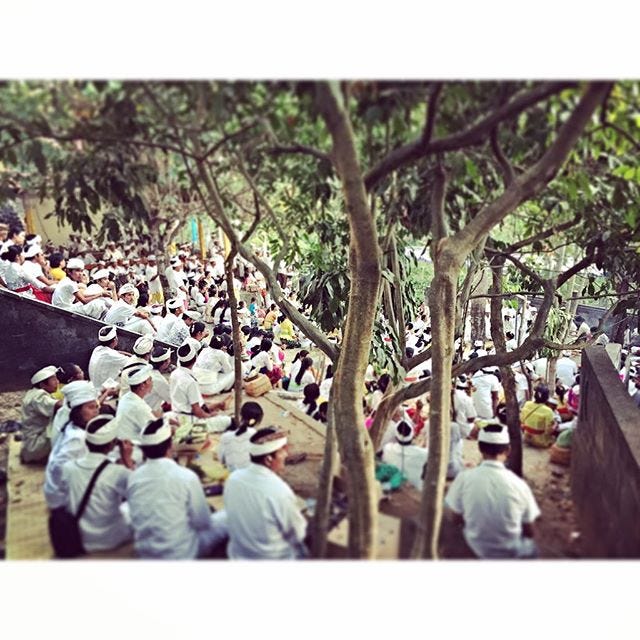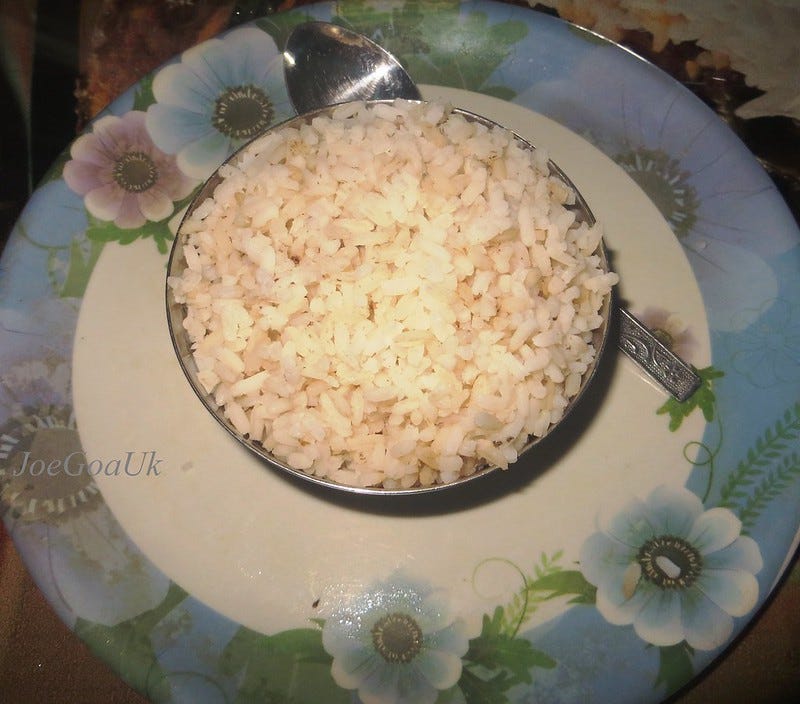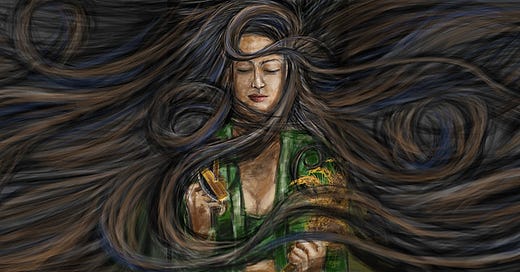A proper last meal. Facts, myths, and the poetry of rice (with an old recipe).
“I don't want you to just sit at the table. I don't want you just to eat, and be content. I want you to walk into the fields”
Hey, I hope you are doing good. Welcome to another post in the section It’s Food o’ Clock. Here I share interesting writings about food (recipes, history, storytelling, and curiosities). Today I post about one of my favorite food items, rice. Do you like rice? Make sure to subscribe, leave a comment, and share to support my work. If you feel more generous become a paid subscriber for $5 a month for additional content.

Not everyone gets their last preferred meal. Things like what we'd like to eat for our last bite are only reserved for a few lucky ones. Yet most of us have in mind what kind of meal would be our least, had we had a say in the matter. For me, it would be a simple dish made of butter sauteed day old rice, and a fried egg on top. But I can settle for simple boiled white rice as well. Give me rice, and I'll die happy!
Rice is a quintessential food for many people. Even some cultures who originally didn't have it because their lands couldn't grow it, love it. It is everywhere. For some it means happiness and nutrition, and for some it means being poor and a load of carbs. But rice means many things. In the book The Complete Language of Food, S. Theresa Dietz writes about the symbology of rice, pointing that it can mean “fertility” and “remembrance”. She also shares about the “possible powers” of such a delicious food. People attribute to it properties like air elements, fidelity, luck, and wealth.
Rice has been a life saver for many families and cultures during tough times. These (tough times) can create different meanings in different countries and regions. Two people could have grown up eating technically the same dish, and still perceive it differently. For example, the dish I mentioned above (the one I'd wish to eat as my last meal) is seen by a friend of mine as the worst thing ever. He told me once that growing up in Colombia they were so poor that rice and fried eggs was their everyday food. This food brings back bad tasting memories for him. We can see how the economic situation in which people grow up can alter the perception of a food. And yet, poor, or rich, hating it or loving it, people eat rice.
According to USDA China, India, Bangladesh, and Indonesia are the top four consumers on earth. There are four types of rice being produced worldwide. Each type has its own preferred regions to grow.
Indica rice dominates most of the global trade and is produced in tropical and subtropical regions.
Aromatic rice such as jasmine and basmati are primarily grown in Thailand, Vietnam, Cambodia, India, and Pakistan.
Japonica rice prefers cooler climates such as Japan, North and South Korea, Russia, and parts of Egypt
Glutinous rice is grown in Southeast Asian countries such as Thailand, and Laos.
Dishes of the world
With such diversity and the distinct cultural preferences and meanings, rice is not short on recipes and ways to enjoy it. The book The Gourmet Atlas: The History, Origin, and Migration of the Foods of the World says that “rice is the most significant grain grown worldwide”. According to the authors, an estimated time of origin points to China 3000 BC. In it, the authors share a list of fifteen different rice dishes of the world:
Indonesia: Rystaffel.
China: Lotus Rice
Thailand: Coconut Rice
Japan: Sushi
India: Biryani
Iran: Pollo
Turkey: Pilau
Iraq: Timman
Libya: Riz el Tammar
Jordan: Riz bi Sh’Riyah
Saudi Arabia: Dajaj M’Ashi
Morocco: Poulet farci
Italy: Risotto
Spain: Paella Valencia
England: Rice pudding
U.S.A: Boiled rice
The poetry of rice
Rice is not just a food; it is also a culture. There is art, music, and literature that offer great renditions to it. In her poem Rice writer Mary Oliver encourages us to not just sit at the table and eat rice. She wants us to feel the grounds in which it grows. With her lines she takes things like taste, nutrition, experience, and meaning beyond the plate itself.
“It grew in the black mud.
It grew under the tiger's orange paws.
Its stems thicker than candles, and as straight.
Its leaves like the feathers of egrets, but green.
The grains cresting, wanting to burst.
Oh, blood of the tiger.
I don't want you to just sit at the table.
I don't want you just to eat, and be content.
I want you to walk into the fields
Where the water is shining, and the rice has risen.
I want you to stand there,
far from the white tablecloth.
I want you to fill your hands with mud,
like a blessing.”
Celebration and mythology

Rice is celebrated around earth in many ways. Throughout history many festivals have been created in its honor. Being a lover of rice, I would certainly appreciate visiting these events. Here is a list of some interesting rice festivals:
In Osaka, (Japan) they celebrate the Otaue Rice Planting Festival. This is a colorful celebration where they dress as Samurai and perform “rice-planting rituals” in hopes for prosperous harvesting in the coming cycle, and to give thanks for the previous one.
In Louisiana (USA) they bring the International Rice Festival. This event has been happening since the late 1930s. “In honor of the rice industry and its hard-working farmers” people take part in many activities. Among the events in this celebration there is a “must see” rice eating contest.
During the Fiestas del Arroz the town of Sueca in Spain (also known as “the town of rice”) they celebrate the International Paella Competition.
The festivals Makar Sankranti and Pongal in India are celebrated in gratitude for a good harvest. In these festivities rice plays the leading role due to its symbolic meanings of “abundance” and “prosperity”.
Beyond festivals and tasty sounding dishes, rice has a mythological and a folkloric component that varies from culture to culture. For example, the story of ‘the fleeing rice soul' of the Khmer people tells us that one day a young husband and wife bothered the god of rice, and the consequences were devastating for their community. Fleeing to another place to seek peace, the god left behind hunger and starvation (no more rice). Sometime later a person was chosen to “persuade” the god to return, and after accomplishing his task the Khmer people could eat rice again. Here is a list of other rice related myths and folklore:
In Louisiana (US) it is said that “the test of true Cajun is whether they can calculate the precise quantity of gravy needed to accompany a crop of rice growing in a field”.
In Puerto Rico, if rice is not part of a festivity something is missing. Be it a birthday, a Christmas party, or a wedding at least they must have ‘un arrocito por el lado’ (a little rice on the side).
For the Dan people in Liberia and Côte d'Ivoire (Africa), a special rice spoon is given to the “most hospitable woman in a village”. Then “she parades with the spoon and is expected to host a feast highlighting rice”.
A recipe from the past

Rice can be cooked in many ways, but simplicity and basics are as enjoyable as the most complex dishes. In the book El Cocinero Puerto-Riqueño (The Puerto-Rican Cook - 1859) we can find an easy recipe for Creole white rice (Arroz blanco criollo) that can be eaten alone or accompanied by something else. Besides connecting me to my culture, what I love about this recipe is that it takes us back to a time when cooking instructions were expressed differently to what we are used to nowadays. The recipe goes as like this:
“Place a saucepan with more than a jug of water with its corresponding salt, on the fire. After it is boiling, add the rice that does not exceed one pound, which is the calculated amount, well washed. Let it cook until all the water is used up. Separately, fry four cloves of garlic in four tablespoons of shortening. Once they are golden, they are taken out, and the shortening is only added to the cooked rice on top, always taking care that it is cooked and grainy, which is the merit of white or Creole rice.”
In a way, rice is special because there are few other foods like it. It is so abundant that it can feed many people on earth. But rice is also special because of culture and tradition. Each society and its different regions have contrasting flavors, aromas, ways to serve, and mythology. Rice evokes emotions and movement. It nurtures and it gives meaning. If I had a saying about what would be my final plate of food, I’d say that rice makes for a proper last meal.



